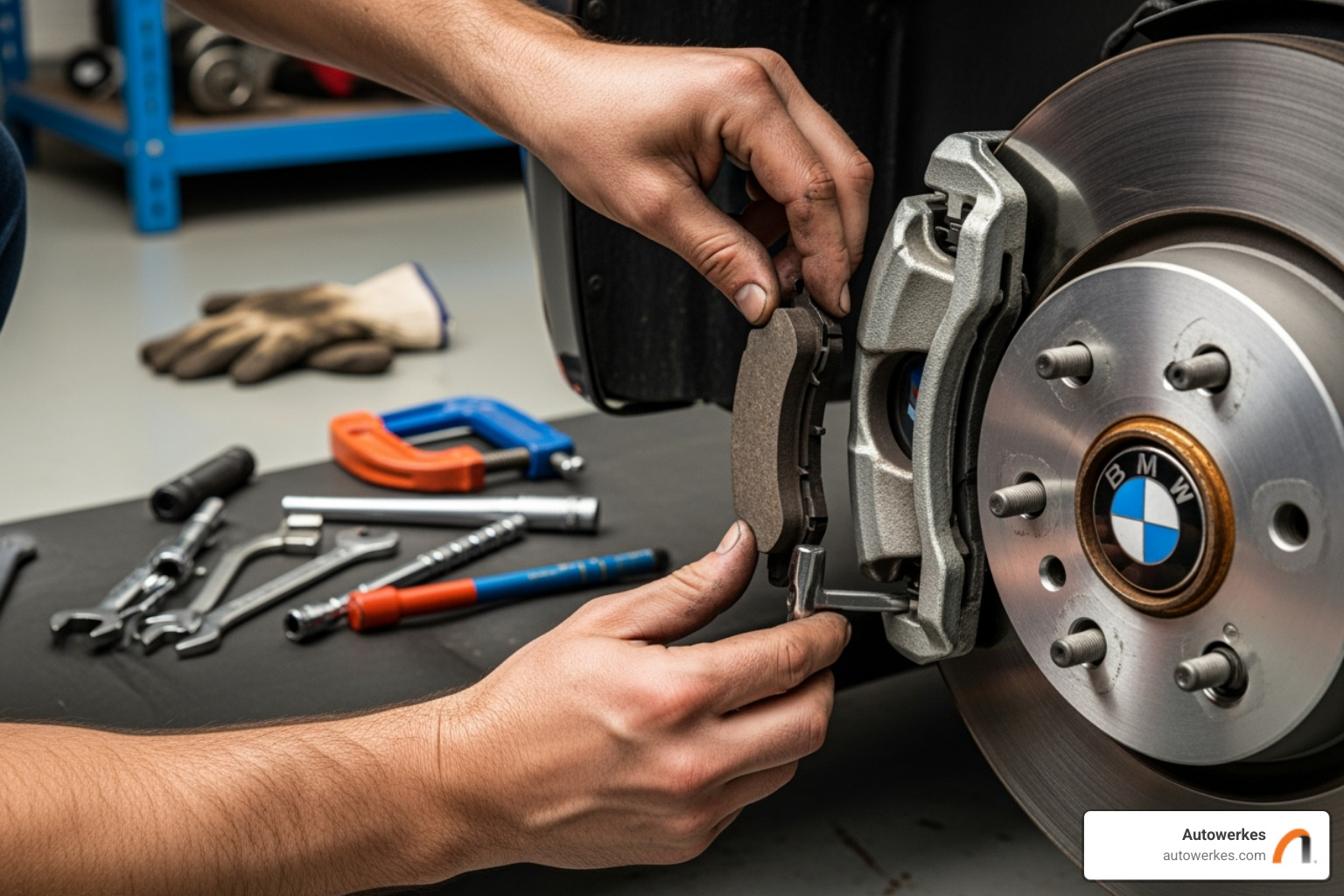Shocking Simplicity: A Step-by-Step BMW Suspension Refresh
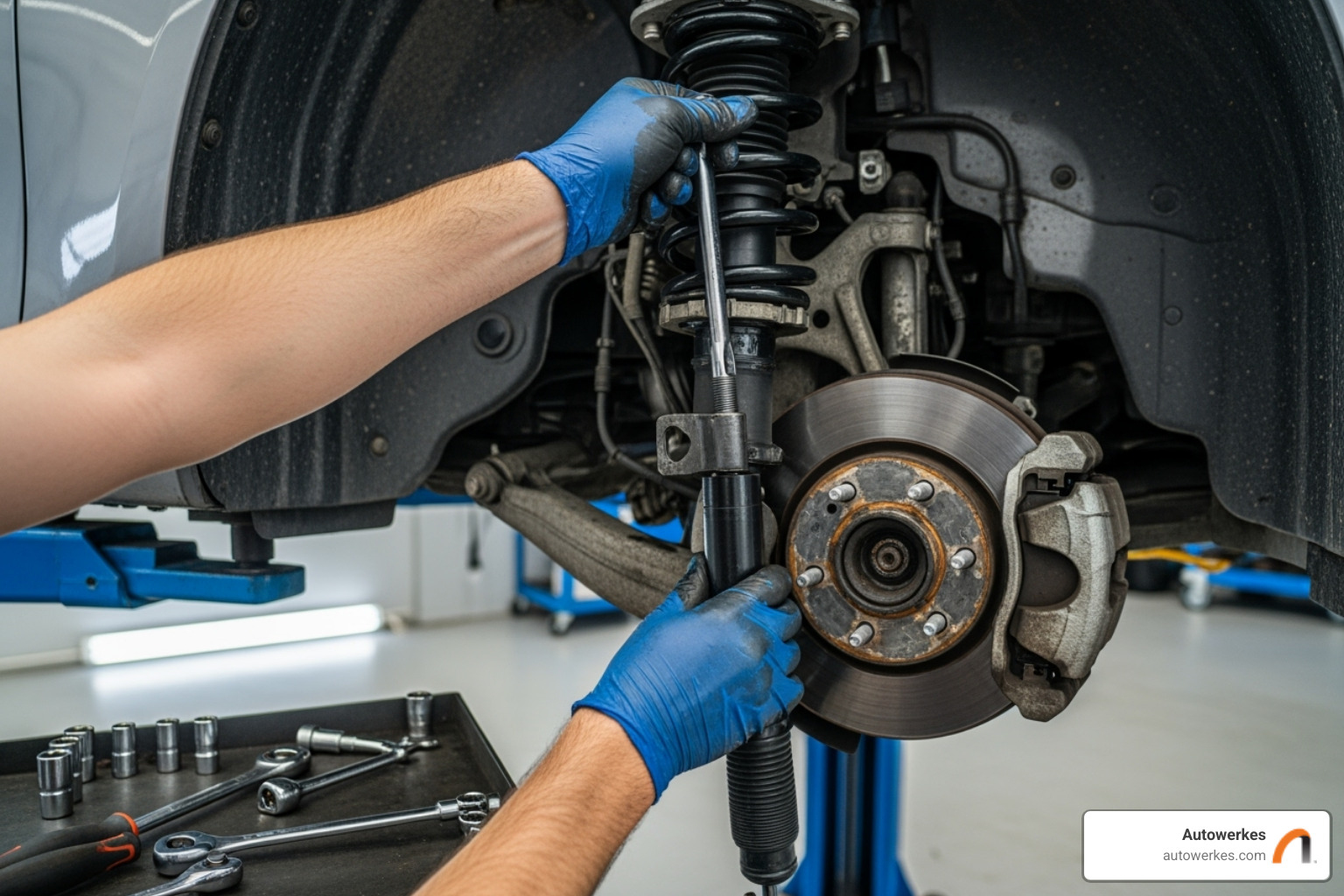
Restoring Your BMW's Ultimate Driving Machine Feel
BMW shock replacement is a critical maintenance procedure for preserving your vehicle's legendary driving dynamics and safety. Your BMW's suspension is the foundation of the "Ultimate Driving Machine" experience, delivering the precise handling, smooth comfort, and confident control you expect.
Quick BMW Shock Replacement Guide:
- Typical lifespan: 50,000-100,000 miles depending on driving conditions
- Replace in pairs: Always replace both shocks on the same axle for balanced performance
- Key warning signs: Bouncy ride, nose-diving during braking, fluid leaks, clunking sounds
- Professional service recommended: Complex spring compression and electronic coding requirements
- Alignment required: Post-replacement wheel alignment ensures optimal tire wear and handling
Your BMW's shocks and struts work together to control spring movement, maintain tire contact with the road, and absorb impacts from bumps. When these components wear out, you'll notice a dramatic decline in ride quality and handling precision.
The average lifespan of BMW shock absorbers is 50,000 to 100,000 miles, depending on driving conditions. City driving on rough roads can reduce this lifespan, while smooth highway driving may extend it.
Modern BMWs often feature advanced systems like Electronic Damping Control (EDC) or Adaptive M suspension, which require specialized knowledge for proper service. These systems may need electronic coding after shock replacement—a service that demands BMW-specific expertise.
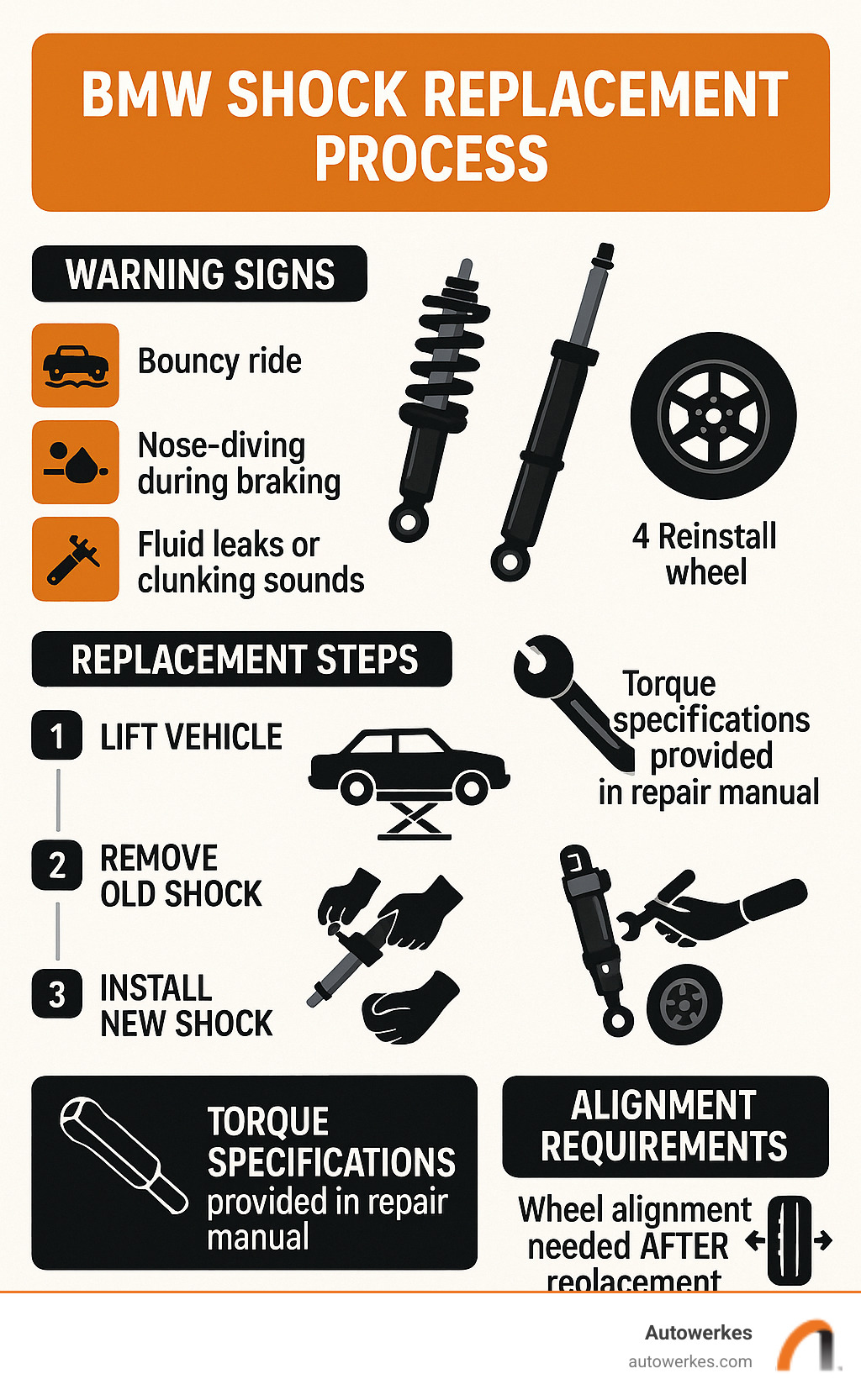
Glossary for bmw shock replacement:
The Ultimate Guide to BMW Shock Replacement
When to Replace: Recognizing the Telltale Signs of Worn Shocks
Your BMW's shock absorbers work tirelessly, but they eventually wear out. When they do, your ultimate driving machine starts feeling less than ultimate. Recognizing the following signs is key to knowing when it's time for a replacement.
The most obvious sign is a bouncy ride and reduced comfort. If your BMW feels like it's floating after hitting a bump, continuing to bounce when the road is smooth, your shocks have likely lost their ability to control spring movement effectively.
Nose-diving during braking is another telltale sign that demands attention. When you brake and the front of your car dips dramatically, your front shocks aren't providing proper resistance. This is a safety issue that can significantly increase your stopping distance.
You'll also experience poor handling and stability as shocks wear. The precise, connected feeling BMW is famous for starts to fade. Your car might feel "floaty" at highway speeds, exhibit excessive body roll in corners, or feel less responsive to steering inputs.
Keep an eye on your tires for uneven tire wear, particularly cupping or scalloping on the tread. When shocks can't keep your tires firmly planted on the road, they bounce and skip, creating inconsistent contact. This means buying tires more frequently and indicates a suspension problem.
A visual inspection might reveal fluid leaks from the shock body—oily streaks down the side of your shock absorbers. Shocks rely on hydraulic fluid, and when the seals fail, that fluid escapes. Leakage means the shock is done and needs replacement.
Don't ignore clunking or knocking sounds from your suspension over bumps or rough pavement. These noises often indicate worn internal components or loose hardware, both signs that your BMW shock replacement can't wait.
Critically, worn shocks lead to increased braking distance. When tires don't maintain consistent road contact, your braking system can't perform optimally. In an emergency, those extra feet could make all the difference.
The typical lifespan of BMW shocks ranges from 50,000 to 100,000 miles, but this varies with driving conditions. If you steer the rough city streets of Los Angeles or Orange County, you might see wear closer to the 50,000-mile mark. Highway cruising, however, can help your shocks last much longer.
For more insights into what to watch for in your BMW, check out our guide on 5 Common BMW Issues to Watch For.
Choosing the Right Parts: Understanding BMW Suspension Options
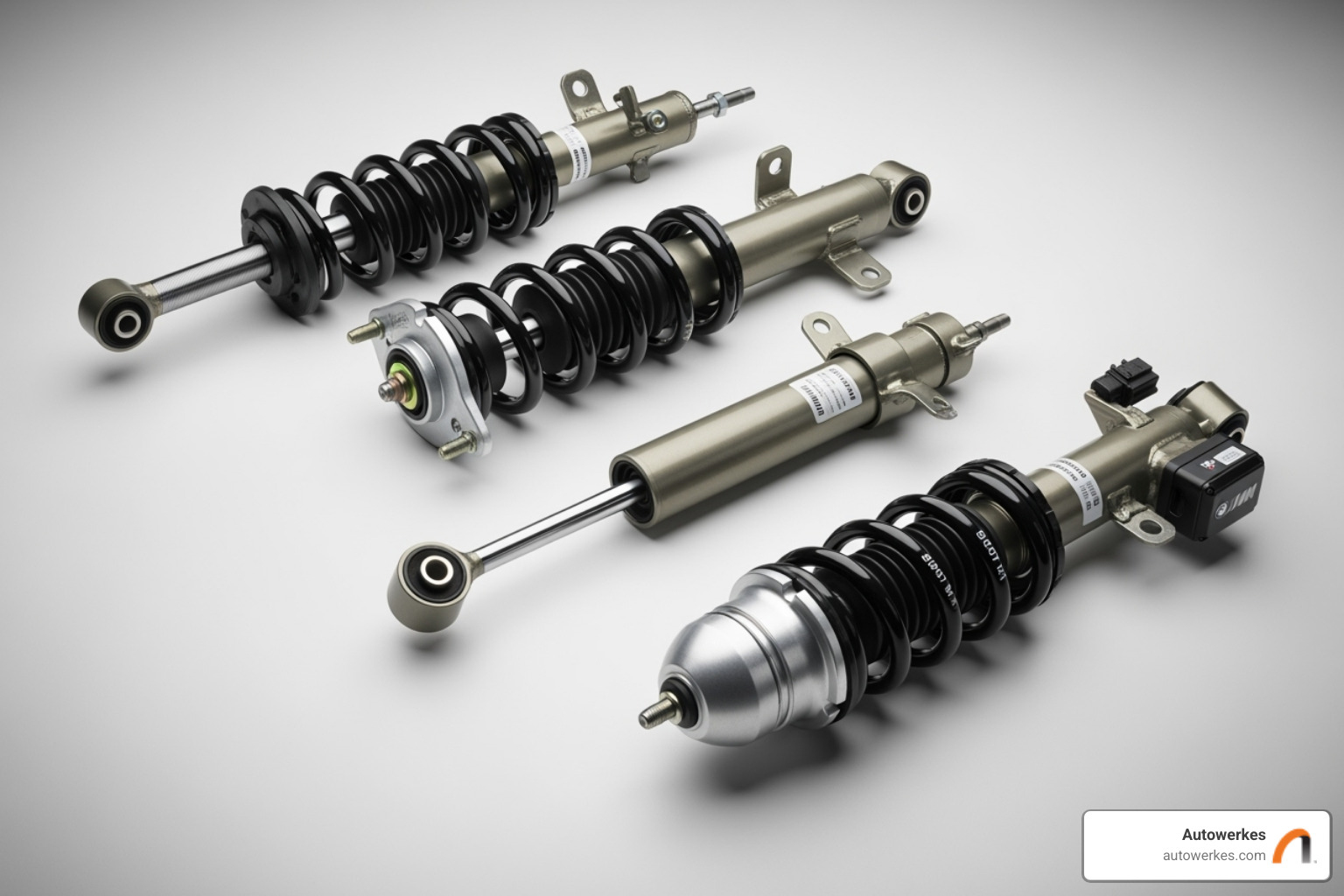
When it comes to BMW shock replacement, choosing the right parts is essential for maintaining the precise driving experience you love. The wrong choice won't just affect comfort; it could impact your entire performance.
At Autowerkes, we consistently recommend Genuine BMW (OEM) parts. These components are engineered to BMW's exacting standards, ensuring a perfect fit, optimal performance, and longevity. While aftermarket options exist, OEM parts guarantee your BMW retains its original character. Many OEM BMW parts are manufactured by respected companies like Sachs and Bilstein.
BMW offers several suspension types to match different driving preferences. Standard suspension provides balanced comfort and control for daily driving. M-Sport suspension steps things up with stiffer springs and shocks for more spirited driving, reducing body roll and sharpening responses. Adaptive suspension (EDC - Electronic Damping Control) is a technological marvel that adjusts damping in real-time based on road conditions and your selected driving mode.
Model-specific requirements make choosing parts complex. A 3-Series shock won't work on a 5-Series, and variations exist even within the same model. For instance, an X5 with third-row seating requires different rear shocks than a two-row version. Packages like M-Sport or Adaptive Drive further complicate the selection.
The most reliable way to identify the correct parts for your BMW is through its Vehicle Identification Number (VIN). This 17-character code tells us exactly how your BMW was built, including its specific suspension. At Autowerkes, we use your VIN and BMW's parts catalog to ensure perfect compatibility.
Quality and compatibility matter. Using standard shocks on a vehicle designed for sport suspension results in excessive softness and poor handling. Conversely, installing sport shocks on a comfort-tuned vehicle creates a harsh ride. For EDC-equipped vehicles, using non-compatible shocks renders the electronic system useless and triggers error messages.
The BMW Shock Replacement Process: A General Step-by-Step Guide
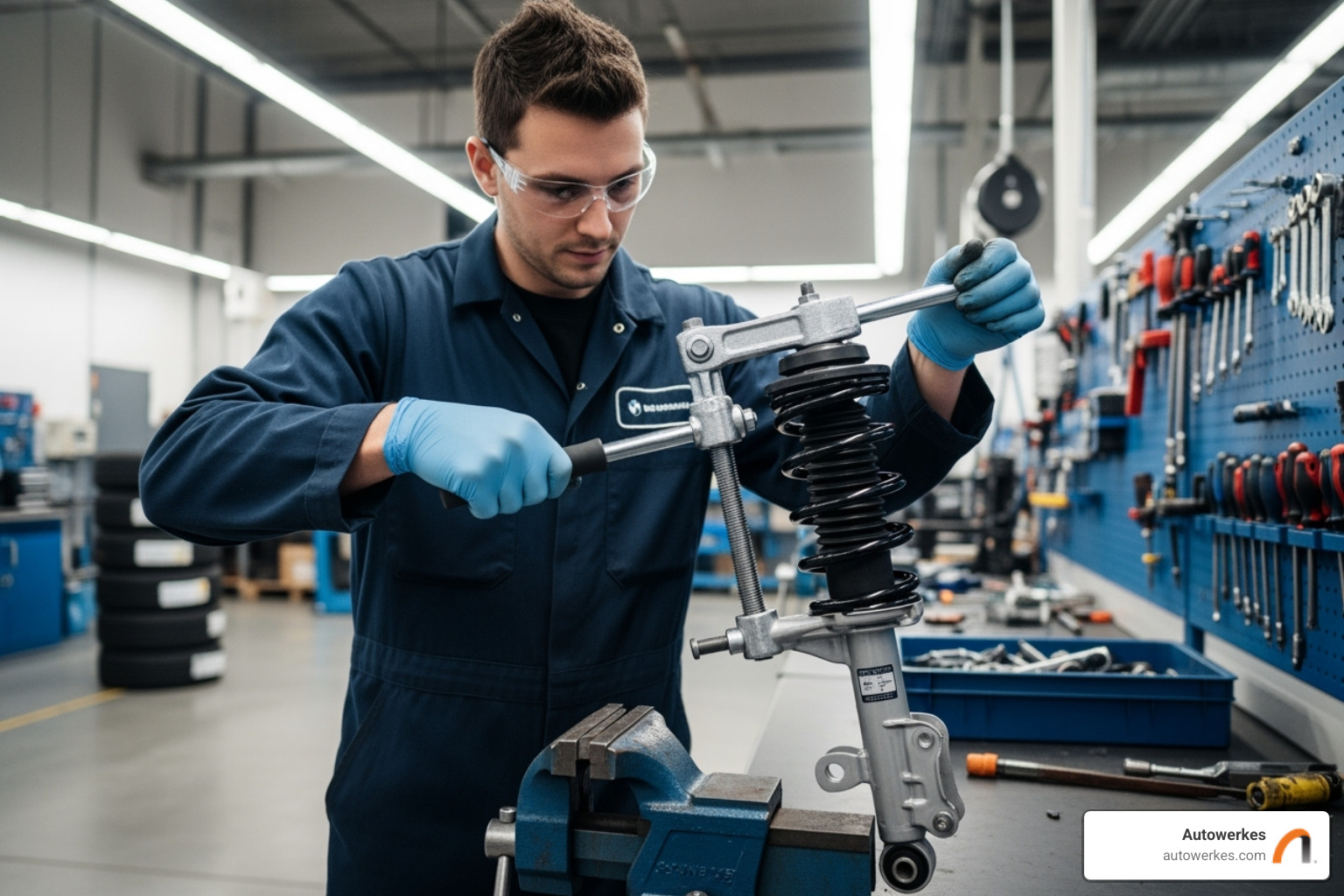
When facing a BMW shock replacement, the first decision is whether to DIY or trust the professionals. While rear shock replacement can be straightforward for experienced DIYers, front strut replacement is a different story. MacPherson strut designs require spring compressors—tools that can be dangerous without proper training. Those springs are under tremendous pressure, and improper handling can cause serious injury.
At Autowerkes, we handle these complex procedures daily with specialized tools and extensive BMW knowledge. Our team understands the intricacies of electronic suspension systems and the nuances of a great repair. We offer comprehensive Performance Repair Services that restore your BMW's factory precision.
Regardless of who performs the work, safety precautions are non-negotiable. Your BMW must be properly lifted and supported on sturdy jack stands. Professional-grade tools, including calibrated torque wrenches, are essential for safe reassembly.
Here's a fundamental rule: always replace shocks in pairs on the same axle. While only one shock might fail, its partner has experienced similar wear. Installing one new shock alongside a worn one creates an imbalanced system that compromises handling and accelerates wear on the new component.
The general replacement process varies between models. After safely lifting your BMW and removing the wheels, front strut replacement often requires removing brake components, while rear shock access might involve some interior trim removal.
Disconnecting necessary components typically involves sway bar end links and control arm connections. Once freed, the old shock or strut assembly is carefully removed. For struts, this is where the spring compressor becomes critical for safely separating the spring from the old strut.
Torquing bolts to BMW specifications is a safety requirement. Every fastener has a specific torque value engineered by BMW. Incorrect torque can lead to catastrophic component failure or damage threads. This requires proper tools and adherence to specifications.
The importance of post-replacement wheel alignment cannot be overstated, particularly after front strut replacement. Even minor changes in suspension geometry affect your alignment, leading to uneven tire wear and compromised handling. A professional four-wheel alignment ensures your BMW tracks straight and maximizes tire life.
Understanding the Costs and Complexities of BMW Shock Replacement
Planning for a BMW shock replacement involves understanding both the financial investment and the technical complexities of modern BMWs. It's not simply unbolting old parts; today's sophisticated cars require specialized knowledge.
The total cost breaks down into parts versus labor expenses. Parts costs vary dramatically by suspension type—standard shocks cost less than sport variants, which cost less than adaptive electronic units. We consistently recommend OEM parts for guaranteed fit and performance.
Labor costs reflect the complexity of your specific vehicle. Front strut replacement typically involves more labor due to spring compression requirements. Rear shock replacement is often more straightforward but varies between models.
When comparing dealership versus independent shop pricing, dealerships typically charge premium rates. Specialized independent shops like Autowerkes provide the same expertise and quality at more competitive rates. We serve clients throughout Huntington Beach, Newport Beach, and Los Angeles with transparent pricing.
Electronic Damping Control (EDC) adds significant complexity and cost. EDC-equipped vehicles use electronically controlled dampers that are more expensive and require specialized handling. After installation, these systems often need coding and programming for the car's computer to recognize the new components. This programming is part of our Electrical Repair Services, as improper coding can lead to errors or system damage.
Regarding BMW warranty coverage, shock absorbers are considered wear items and are not typically covered unless there's a clear manufacturing defect. Even if a warranty covers one defective shock, safety and performance still dictate replacing both on the axle.
This brings us to why replacing both shocks is crucial for safety and performance. Installing one new shock with one worn one creates dangerous imbalances. Your BMW might handle unpredictably, pull to one side during braking, or experience accelerated tire wear. The new shock will work harder to compensate for its worn partner, shortening its lifespan. Replacing a single shock is a false economy that often leads to greater expenses and safety risks.
Keep Your BMW Performing Flawlessly with Expert Care
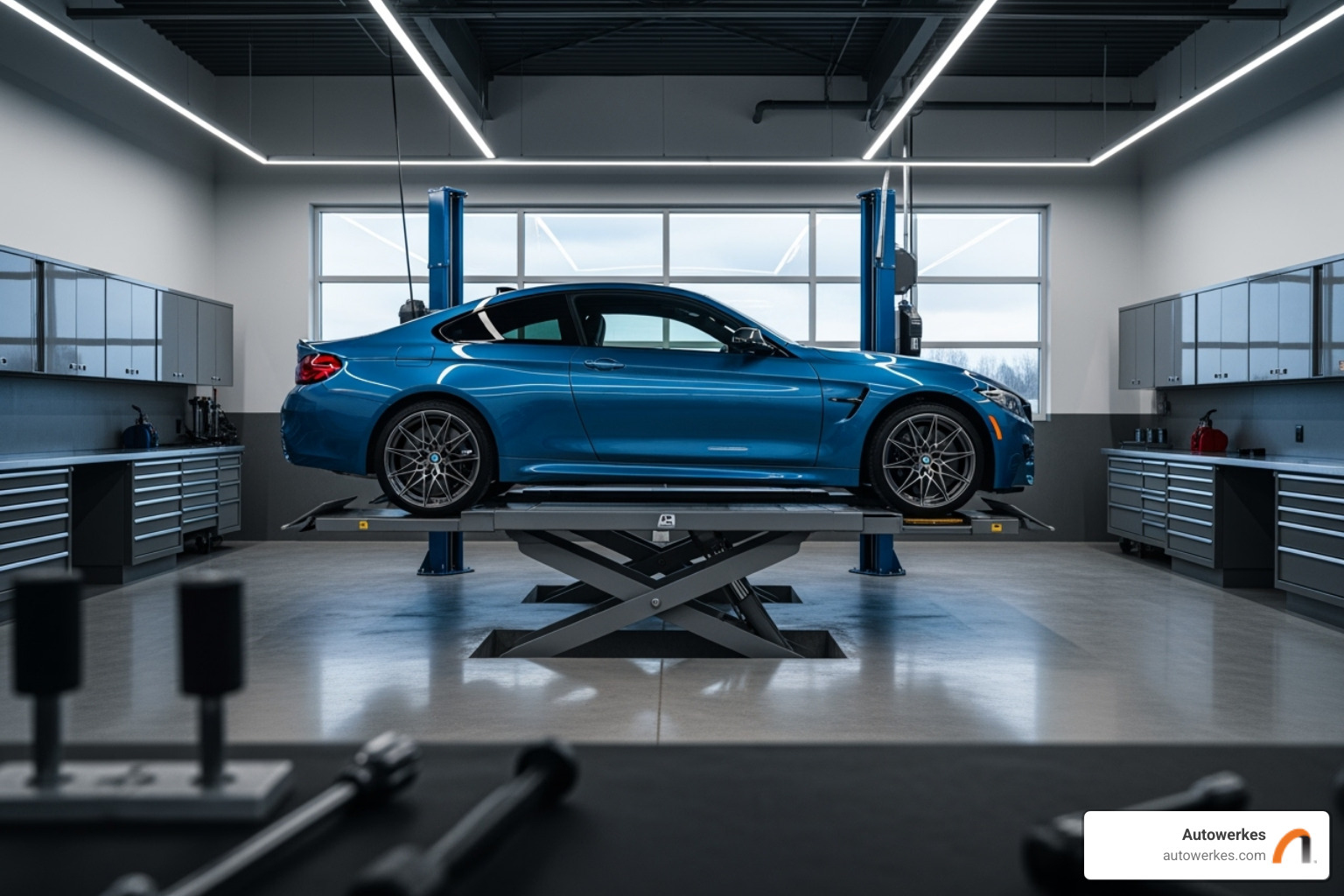
Maintaining your BMW's precision requires expertise. This guide has covered the key takeaways for BMW shock replacement: recognizing warning signs, understanding part complexities, and the critical importance of replacing shocks in pairs.
Professional service is crucial for safety and optimal handling. A bmw shock replacement is about maintaining the balance between your tires and the road. With front struts, the risks of DIY attempts are significant due to high-pressure springs that can cause serious injury if handled improperly.
Modern BMWs add complexity with advanced electronics. Whether your car has standard, M-Sport, or adaptive EDC suspension, each system has specific coding requirements that demand specialized equipment. This is where BMW specialists stand apart from general repair shops.
Autowerkes' expertise ensures your BMW's suspension is in top shape. Our technicians understand the nuances of different BMW models, from a 3-Series to an X-Series SUV. We know an X5 with third-row seating needs different shocks than a five-seat version. This detail-oriented approach, using genuine BMW parts and precise torque specs, restores the "Ultimate Driving Machine" feel.
We are proud to be serving Huntington Beach and surrounding areas in Southern California. Whether you're in Newport Beach, Los Angeles, Laguna Beach, or Mission Viejo, your BMW deserves care from technicians who understand the vehicle and local driving conditions.
Your investment deserves protection. Don't let worn shocks compromise your safety or the driving experience.
Ready to restore your BMW's performance and safety? Schedule your BMW auto repair appointment with the suspension specialists at Autowerkes today.

.svg)



